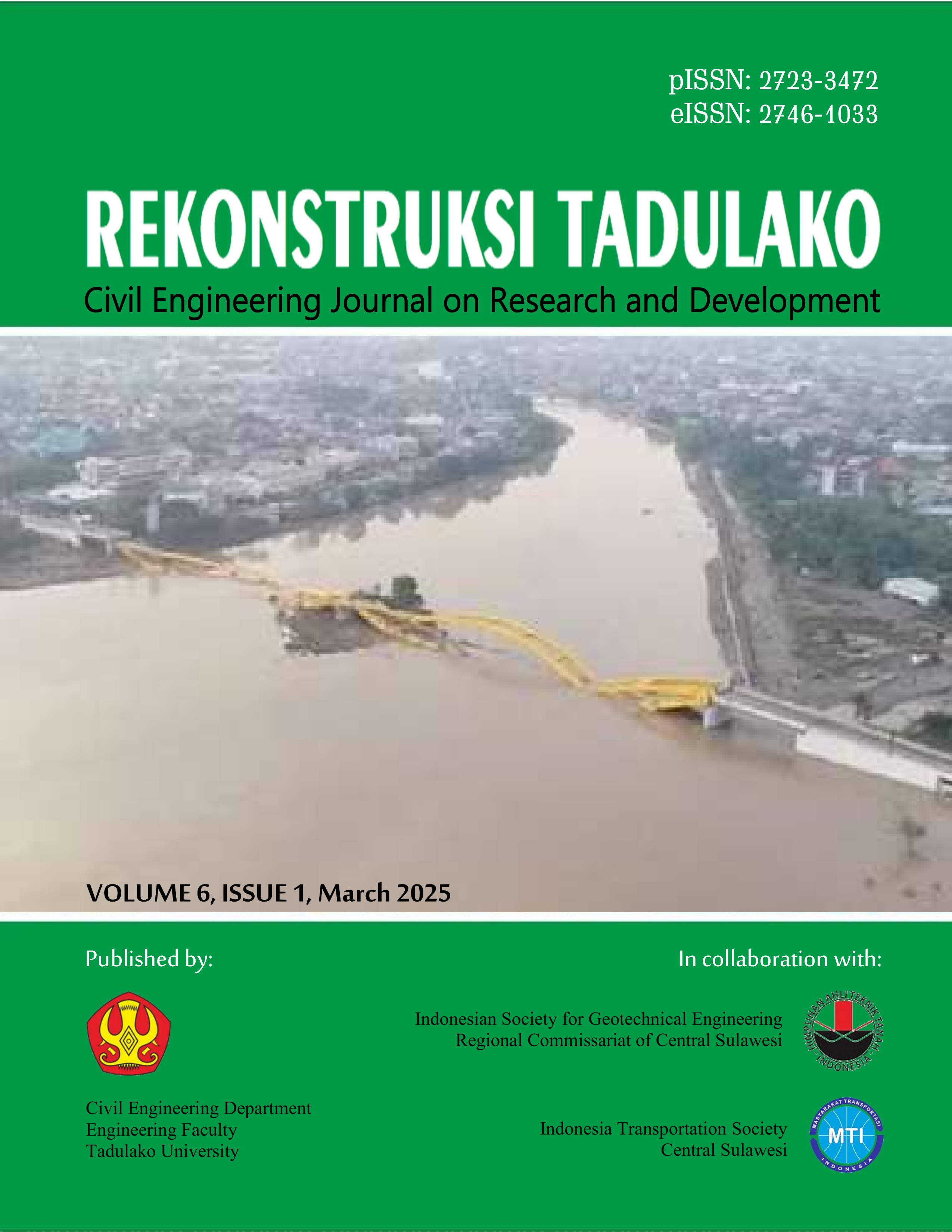Studi Pengaruh Penambahan Abu Batu Sebagai Pengganti Pasir Pada Beton Mutu K-250
DOI:
https://doi.org/10.22487/renstra.v6i1.712Keywords:
stone ash, filler, concrete, concrete compressive strengthAbstract
The handling of stone ash waste from the by-product of the Quarry C crushed stone factory with the number of factories along the Palu-Donggala road has not been handled properly until now. The potential for utilization for building materials such as lightweight concrete, paving blocks and rosters as well as fillers for asphalt concrete mixtures and rigid pavements at airports is still large to be developed. Based on this, stone ash waste can be used as a building material to build structures and infrastructure. However, the characteristics of the basic materials and building materials made from stone ash waste must be re-tested. The analysis was carried out on the results of the concrete compressive strength test (SNI 03-1974-2011), which is a comparative analysis of various conditions of the age of the test object and the percentage of stone ash addition to the weight of fine aggregate obtained from the laboratory. The addition of stone ash as a partial replacement for fine aggregate can increase the compressive strength of concrete by up to 9.64% compared to the compressive strength of normal concrete. The optimum level of stone ash addition as a partial replacement for fine aggregate occurs at a variation of 20% stone ash from the weight of fine aggregate. The compressive strength of 28-day concrete that occurs in this variation is 23.590 MPa, while the compressive strength of concrete without the addition of stone ash is 21.515 MPa. The compressive strength value of concrete with 50% rock ash content has the lowest compressive strength value of 21.137 MPa, where there is a decrease in the compressive strength value of 1.75% compared to the compressive strength value of concrete without the addition of stone ash..
Downloads
References
Ibrahim, M. Malik, and P. Saelan, “Studi Perancangan Campuran Beton Menggunakan Abu Batu Sebagai Agregat Halus”, Rekaracana: Jurnal Teknil Sipil, vol. 5, no. 3, p. 108, 2019.
B.A. Majid, D. Sumarna, and I. Konong, “Uji Eksperimental Kuat Tekan Beton K-300 dengan Menggunakan Material Kali Oba dan Substitusi Fly Ash (Abu Terbang Batu Bara)”, INTER TECH, vol. 1, no. 2, p. 27, 2023.
F. Wisama, F. Elisabeth, and I. Fahroni. “Pemanfaatan Limbah Konstruksi menjadi Villa Serbaguna dengan Pendekatan Green Design”, Jurnal Desain Interior, vol. 4, no. 2, p. 101, 2019.
F. Handayani, “Manfaat Limbah Abu Batu Sebagai Tambahan Material Bahan Bangunan”, Prosiding Seminar Nasional Tahunan Program Studi Magister Teknik Sipil ULM , vol. 6, p. 59, 2019.
J. Harjono, Pengaruh Abu Batu Sebagai Substitusi Agregat Halus Terhadap Sifat Mekanik Beton, Yogyakarta: UAJY, 2017.
I. Hendriyani, R. Pratiwi, and Y. Aprilianus, “Pengaruh Jenis Air Pada Perawatan Beton Terhadap Kuat Tekan Beton”, Jurnal Ilmiah Teknik Sipil TRANSUKMA, vol. 1, no. 2, p. 202, 2016.
A.H. Ahmad, S.F. Yanuar, and R.B. Hamduwibawa, “Studi Pengaruh Jenis Semen Pada Campuran Beton 1:2: ”, Jurnal Rekayasa Infrastruktur Hexagon, vol. 7, no. 2, p. 74, 2022.
M. Setiawati, “Fly Ash Sebagai Bahan Pengganti Semen Pada Beton”, Prosiding Semnastek, vol. 2, p. 1, 2018.
T.F. Luan and M.D. Erfan, “Pengaruh Pemakaian Fly Ash sebagai Cementitiouspada Beton Mutu Tinggi Terhadap Kuat Tekan Beton Umur 28–91 Hari”, Sondir, vol. 1, p. 78, 2020.
F.M.V. Gobel, “Nilai Kuat Tekan Beton Pada Slump Beton Tertentu”, Radial, vol. 5, no. 1, p. 22, 2019.
F.P. Pane, H. Tanudjaja, and R.S. Windah, “Pengujian Kuat Tarik Lentur Beton dengan Variasi Kuat Tekan Beton”, Jurnal Sipil Statik, vol. 3, no. 5, p. 313, 2015.
W.I. Dharmawan, D. Oktarina, and M. Safitri, “Perbandingan Nilai Kuat Tekan Beton Menggunakan Hammer Test dan Compression Testing Machine Terhadap Beton Pasca Bakar”, Media Komunikasi Teknik Sipil, vol. 22, no. 1, p. 35, 2016.
N.S.M. Siahaan, M.D. Sumajouw, and M.R. Mondoringin, “Penggunaan Styrofoam Sebagai Substitusi Parsial Agregat Kasar Terhadap Nilai Kuat Tekan dan Kuat Tarik Belah Beton Ringan”, Jurnal Sipil Statik, vol. 8, no. 4, p. 635, 2020.
E. Widyananto, N. Alami, and H. Suladi, “Analisis Kuat Tekan Batako dengan Agregat Halus Abu Batu Dan Limbah Styrofoam”, Surya Beton: Jurnal Ilmu Teknik Sipil, vol. 5, no. 2, p. 53, 2021.
SNI 03-1968-1990, Metode Pengujian Analisis Saringan Agregat Halus dan Kasar, Jakarta: Badan Standardisasi Nasional, 1990.
N.A.W. Samawi, Y.A. Saputro, and N. Hidayati, “Analisis Mutu Beton Berbahan FABA (Fly Ash Bottom Ash) Sebagai Pengganti Agregat Halus Dengan Mengacu Proporsi Campuran Pada Analisa Harga Satuan Pekerja”, Jurnal Civil Engineering Study, vol. 4, no. 1, p. 66, 2024.
Anggraini and Muthia, “Pengaruh Porositas Agregat Terhadap Rongga Dalam Campuran Beraspal Panas”, Program Studi Teknik Sipil, vol. 4, no. 1, p. 14, 2018.
Downloads
Published
How to Cite
Issue
Section
License
Copyright (c) 2025 REKONSTRUKSI TADULAKO: Civil Engineering Journal on Research and Development

This work is licensed under a Creative Commons Attribution 4.0 International License.







 This work is licensed under a
This work is licensed under a 


